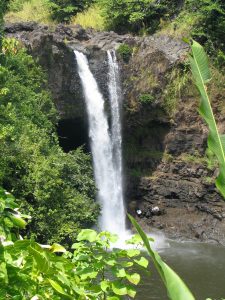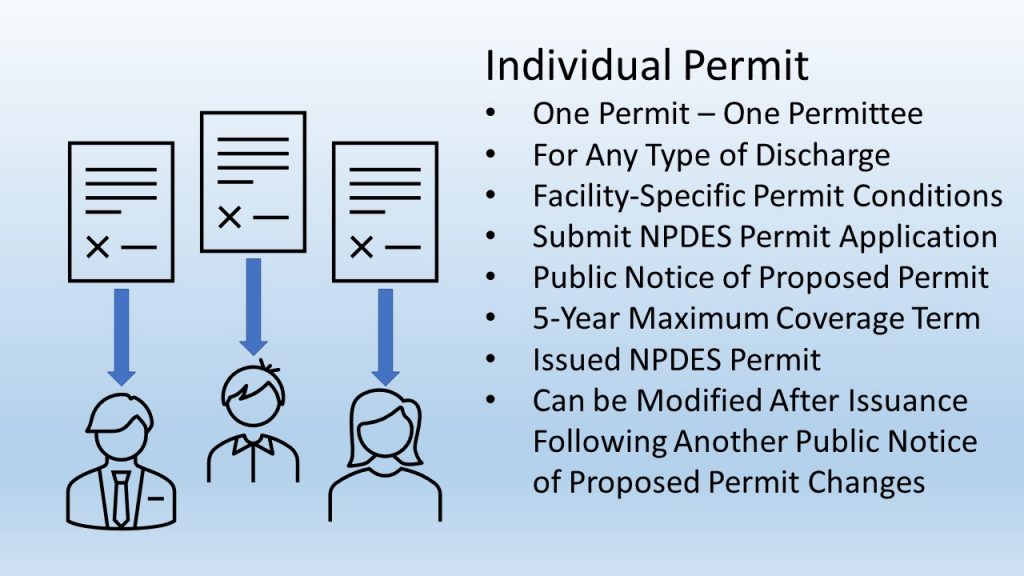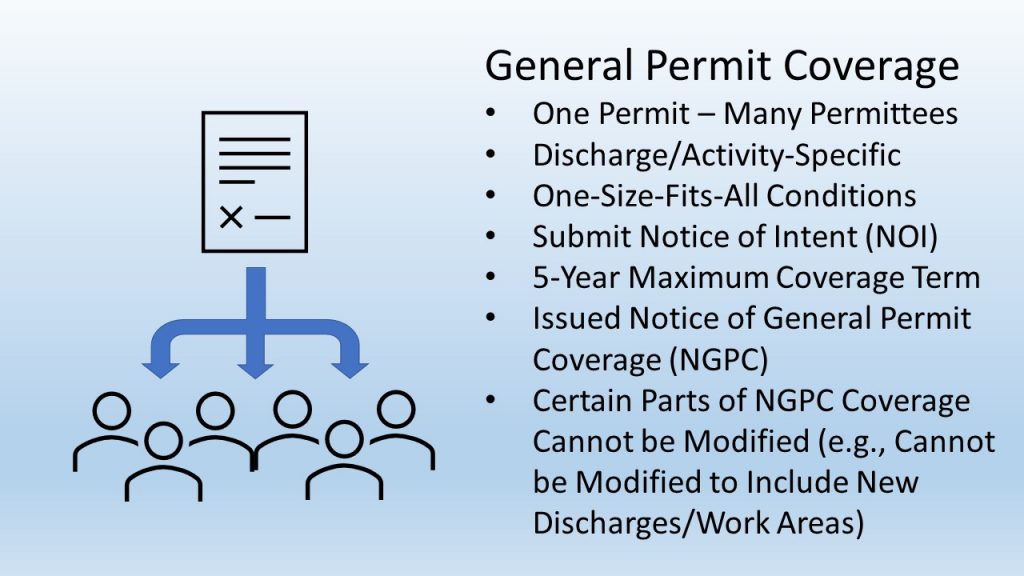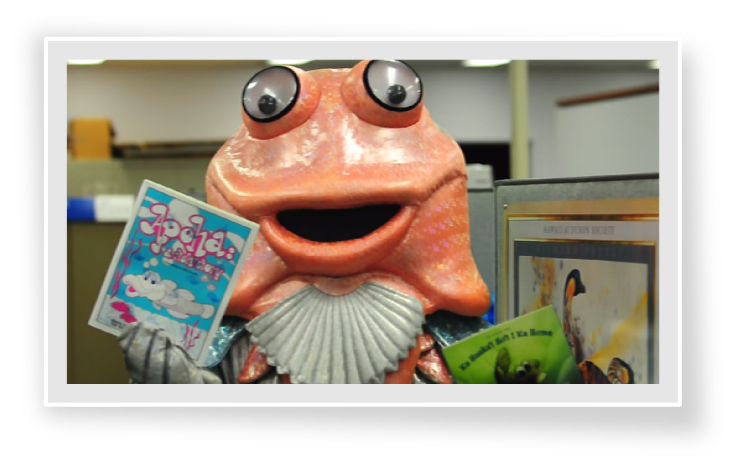NPDES Permits and How to Apply
| On This Page |
Disclaimer
The information provided is intended as a brief and broad overview of the NPDES permitting program in Hawaii as administered by the Department of Health, Clean Water Branch (CWB) and is not to be construed as comprehensive statements of applicability requirements. The information provided is not a substitute for applicable law, policy, or official agency determinations or statements.
The information is intended to provide a basic understanding of Hawaii’s NPDES program and most likely will not address all potential projects/facilities that have situations and conditions unique to that project/facility. If you believe that your project or facility may need to apply for and obtain NPDES permit coverage, it is your responsibility to obtain any additional information, clarification, or additional guidance. If your project or facility needs NPDES permit coverage, it is your responsibility to apply for and obtain NPDES permit coverage prior to discharge or in accordance with any applicable application timelines.
Overview of the Permitting Process
See the below for a basic introduction and instructions on NPDES permits and applicability.
Purpose and History of NPDES Permits
The National Pollutant Discharge Elimination System (NPDES) permitting program as established by the federal Clean Water Act (colloquially known as the Clean Water Act or CWA as of the 1972 amendments to the Federal Water Pollution Control Act) is administered by the Department of Health, Clean Water Branch (CWB) in Hawaii, as authorized by the United States Environmental Protection Agency (EPA).

The Clean Water Act provides protections for the Nation’s surface waters. (Pictured: Rainbow Falls, Big Island, Hawaii, 2004)
The NPDES permitting program was first federally established in the 1972 amendments to the Federal Water Pollution Control Act, which is now commonly known as the Clean Water Act. The Clean Water Act is codified in Title 33 (Navigation and Navigable Waters) of the United States Code from Sections 1251 – 1388 (33 U.S.C §1251 – §1388). The Clean Water Act specifies that the objective of the Act is to restore and maintain the chemical, physical, and biological integrity of the Nation’s waters. One of the more well known goals of the Act is: “it is the national goal that wherever attainable, an interim goal of water quality which provides for the protection and propagation of fish, shellfish, and wildlife and provides for recreation in and on the water be achieved by July 1, 1983;” [from 33 U.S.C. §1251(a)(2)]. This goal is often called the “fishable and swimmable” goal for waters that continues to be a goal for Clean Water Act derived programs across the nation.
The Clean Water Act created a new regulatory framework for managing pollution in the nation’s waterways, one of which was the NPDES permitting program. The NPDES permitting program specifically is established in 33 U.S.C. §1342 (also referred to as Section 402 of the Clean Water Act following the format of the original 1972 document). Broadly, the establishment of the NPDES permitting program now prohibited the discharge of pollutants to the nation’s waterways from certain sources without an NPDES permit. Prior to this, in general, there was no comprehensive regulatory framework or programs that managed or regulated sources of pollutants to the nation’s waterways for the purpose of protecting or improving water quality. Through the years, amendments to the Clean Water Act continue to provide more regulatory tools to manage water pollution within the United States. For more information and a copy of the most recent amended Clean Water Act text, see EPA’s Summary of the Clean Water Act page.
As allowed under the Clean Water Act, the federal implementing agency (EPA) may authorize States, Territories, and Tribes to administer the NPDES program in that entity’s jurisdictional area, under oversight from the EPA. The State of Hawaii, Department of Health was first authorized to administer the NPDES permitting program within the State in November of 1974. For more information on the history of water pollution control management by the Department of Health see our History and Mission Statement page.
The Hawaii NPDES permitting program is a regulatory mechanism to control water pollution through the issuance of permits. The purpose of issuing an NPDES permit is to implement federal and State water pollution control requirements to help protect human health and the environment. A permit does this by imposing restrictions and requirements on discharges of pollutants from permitted sites/facilities. Permittees (entities that a permit has been issued to) are legally obligated to comply with the requirements specified in the issued permit. Violation of permit requirements may be punishable by requiring specific changes to the facility or operations, fines, or other enforcement actions based on the nature of the violation.
The NPDES permit is a tool to control water pollution. NPDES permits contain limits on what can be discharged, monitoring and reporting requirements, and other provisions to ensure that the discharge does not hurt water quality or people’s health. In essence, the NPDES permit utilizes federal regulations and translates general requirements of the Clean Water Act into specific provisions tailored to the operations of each person discharging pollutants. NPDES permits make sure that a state’s mandatory standards for clean water and the federal minimums are being met.
NPDES permits are solely for the management, regulation, and authorization of point source discharges to surface waters only as allowable under federal and State water pollution control laws and the Clean Water Act. All other activities and actions, including, but not limited to, land use decisions, whether or not construction or industrial activities should be allowed, business operation, zoning, and non-point source pollution are not authorized or approved by NPDES permits. Determining the validity or merits of an activity are outside the scope of any NPDES permit. Issuance of an NPDES permit does not convey any other rights, authorizations, approvals, or any other ability not specified in the permit.
Applicability of NPDES Permits
NPDES permits apply to discharges from regulated point sources to State surface waters, including discharges through drainage systems such as storm drains that outlet to a State surface water. A point source is any discernible, confined, and discrete conveyance, including but not limited to, any pipe, ditch, channel, tunnel, conduit, well, discrete fissure, container, rolling stock, concentrated animal feeding operation, landfill leachate collection system, vessel or other floating craft from which pollutants are or may be discharged. This term does not include return flows from irrigated agriculture or agricultural storm water runoff, except return flows from agriculture irrigated with reclaimed water.
All other activities and actions, including, but not limited to, land use decisions, whether or not construction or industrial activities should be allowed, business operation, zoning, and non-point source pollution are not authorized or approved by NPDES permits. Determining the validity or merits of an activity are outside the scope of any NPDES permit. Issuance of an NPDES permit does not convey any other rights, authorizations, approvals, or any other ability not specified in the permit.
What Activities Need Permits?
Any activity that disturbs one (1) acre or more of land, or for projects that disturb less than one (1) acre of land that are part of a larger common plan of development that will disturb one (1) acre or more of land, are required to have construction storm water NPDES permit coverage. See our Construction Storm Water FAQ for more information on applicability.
Any activity that discharges to a State surface water (including discharges through drainage systems such as storm drains that outlet to a State surface water) that has an issued NPDES general permit as identified in Hawaii Administrative Rules (HAR) Section 11-55-34.02(b) is required to have NPDES permit coverage to discharge. See our NPDES General Permits page for more information on each general permit. Such discharges include:
- Storm Water Associated with Industrial Activities (for an exclusion see our Industrial Storm Water and No Exposure page for more information on industrial storm water permitting applicability and exclusions);
- Storm Water Associated with Construction Activity;
- Treated Effluent from Leaking Underground Storage Tank Remedial Activities;
- Once Through Cooling Water Less Than One (1) Million Gallons Per Day;
- Hydrotesting Waters;
- Construction Activity Dewatering;
- Treated Process Wastewater Associated with Petroleum Bulk Stations and Terminals;
- Treated Process Wastewater Associated with Well Drilling Activities;
- Occasional or Unintentional Discharges from Recycled Water Systems;
- Storm Water and Certain Non-Storm Water Discharges from a Small Municipal Separate Storm Sewer System;
- Circulation Water from Decorative Ponds or Tanks; and
- Point Source Discharges from the Application of Pesticides.
Discharges of treated domestic wastewater, cooling water, and other wastewaters to State surface waters need to have an NPDES permit to discharge.
What Activities May Need a Permit?
Any other discharge to State surface waters from what is considered a point source that contains pollutants may be required to obtain an NPDES permit prior to discharge.
Pollution from Activities not Required to get a Permit
It should be noted that the CWB also enforces compliance with the State water quality standards and surface water pollution generally. In instances where a project or facility was not required to get an NPDES permit yet still causes or contributes to water pollution, the project or facility can still be subject to enforcement action by the CWB for the surface water pollution. An example would be if a construction project has a ground disturbance of less than one (1) acre and therefore would not be required to obtain construction storm water NPDES permit coverage, causes a mud slide into a nearby stream due to inadequate soil stabilization practices. In this case, the CWB can take enforcement action against the owner (or any other responsible party) of the construction project for causing surface water pollution. It should also be noted that CWB will also respond to complaints of surface water pollution that are a result of any project/facility. Not being required to get NPDES permit coverage does not affect any potential enforcement actions if it is found that the project or facility is the source of surface water pollution.
In short:
- Not being required to obtain permit coverage does not absolve you from possible enforcement action if the project/activity is found to have caused water quality issues or violated any other State Water Pollution Control laws; and
- The CWB will still respond to complaints of water pollution that are a result of any project/activity, regardless of whether or not NPDES permit coverage was required.
Types of NPDES Permits
There are two types of NPDES permits: Individual Permits and General Permits.
Individual permits are facility-specific permits that are issued to a specific permittee, after submittal of an NPDES permit application. They are written specifically for the permitted facility and include conditions and requirements that are applicable to that specific facility. This type of permit can be used to cover any type of discharge to State water, provided that the permit includes specific conditions and requirements to ensure that the discharge does not violate State water quality standards. The maximum period of permit coverage is five (5) years, with the opportunity to renew coverage to continue discharge, provided that there is a public notice and public comment period to comment on the proposed renewed permit.
Individual permits are also required to be public noticed and undergo a thirty-day (minimum) public comment period, where members of the public may comment (including support, opposition, or suggested revisions to the permit) on the proposed permit to be issued to the facility. Due to the need to draft a facility-specific permit and the public comment period, processing and issuance of an individual permit is typically a time-consuming process. Once issued, the permit may be modified either by the CWB or by the permittee upon request, provided that there is a public notice and public comment period to comment on the proposed modified permit.
General permits are permits that are issued by the CWB and are not issued to a specific permittee, and are instead written to address a specific type of activity or discharge. Instead, any number of facilities or projects can request to be covered under a general permit, provided they can meet the requirements outlined in the specific general permit they are requesting coverage under. General permits can only cover the types of activities/discharges specified in that specific general permit. If a facility or project has multiple types of discharges, they may separately request coverage under multiple general permits for their facility or project (e.g., a construction project may request coverage for construction storm water and dewatering discharges).
If a discharge or activity does not have a general permit that can cover that discharge, that facility/discharger must apply for individual NPDES permit coverage. To request coverage under a general permit, a discharger must submit a Notice of Intent (NOI). The maximum period of permit coverage of a general permit is five (5) years, with the opportunity to renew coverage to continue discharge, provided that any requirements regarding renewal in the renewed general permit are followed. While a general permit is effective, any eligible facility or discharge may request coverage under the general permit.
Since a general permit lays out all the requirements for the permittee to comply with and has specific submittal requirements for the NOI, processing is generally quick, and much faster than processing an individual permit application. Once approval is granted, the discharge will receive a Notice of General Permit Coverage (NGPC), stating that the facility or project is covered under the general permit. Once the NGPC is issued, NGPC coverage and certain information cannot be modified (contact information may be modified after issuance). Changes to the project that would change what is covered under the NGPC cannot be added to NGPC coverage after issuance. Examples of such changes would be increases to permitted areas, new discharge points, and changes to the nature of pollutants discharged that were not disclosed in the NOI (i.e., new pollutants in the discharge not previously disclosed).
It’s important to note that an NGPC is not a permit, it’s an acknowledgement from the CWB that the project is covered under a general permit. The NGPC is not a substitute for the requirements in the general permit that the project or facility is covered under. The NGPC does not contain all the requirements that the project or facility must comply with; these are contained in the applicable general permit.
Should I Apply for Individual Permit Coverage or General Permit Coverage?
In general, the CWB recommends applying for general permit coverage if there is an applicable (and currently effective) general permit and the facility or project can comply with the terms of the general permit. In certain cases, the Department of Health may require a facility or project to apply for and attain an individual permit instead of general permit coverage, although this is a relatively rare occurrence and would depend on extenuating circumstances specific to that facility or project. Processing an individual permit application is a much more time consuming and expensive process (both in filing fee and cost of newspaper public notice) compared to the general permit coverage process.
In general, an individual permit would be required in the following situations:
- A project or facility is unable to comply with the terms of the general permit, or is otherwise ineligible for general permit coverage;
- There is no effective NPDES general permit for that type of activity or discharge (either the general permit is currently expired or that type of general permit does not exist);
- A project or facility wants to cover multiple discharge activities under one (1) individual permit, as opposed to several general permit coverages; or
- The Department of Health, CWB, as allowed by Hawaii Administrative Rules (HAR) Chapter 11-55-34.05 may require a person covered by a general permit to apply for and obtain an individual permit.
Conditional “No Exposure” Exclusion
Under certain conditions, facilities that require industrial storm water NPDES permit coverage may request an exclusion from NPDES permitting requirements. An exclusion from NPDES industrial storm water permitting requirements is called a Conditional “No Exposure” Exclusion. In general, the requirements to be eligible for a Conditional “No Exposure” Exclusion are that all industrial activities at the facility and other industrial pollutant sources (e.g., storage tanks, stockpiling areas, maintenance activities, etc.) are either under cover or contained/sealed in such a way that it will not be in contact with storm water. See our Industrial Storm Water and No Exposure page for more information.
How to Apply for Coverage
See the below for a basic introduction and instructions on how to apply for NPDES permit coverage and the application approval process.
The CWB uses the e-Permitting Portal as the way to fill out NPDES permit applications, NOIs, and other forms. To use the e-Permitting Portal you must first create an account by clicking on the register button in the top right. Once you have created an account, use the Form Finder button to look for the form you want to submit. Use the My Submissions button to look at in progress forms and previously submitted forms.
Please be sure to carefully read the instructions on the form you are submitting to ensure that you have followed all procedures to fully submit your form.
Click here to access the e-Permitting Portal.
Electronic Signature vs. Wet Signature Forms
There are currently two types of forms available on the e-Permitting Portal, wet signature forms and electronic signature forms. Electronic signature forms have Electronic Signature as part of the form name (e.g., Electronic Signature NOI Form) to distinguish them from the wet signature forms. To use electronic signature forms, you must first set up an e-Permitting Portal account and request electronic signature approval. See our Electronic Signature FAQs for more information on how to set up Electronic Signature approval for your e-Permitting Portal account.
The main difference between electronic signature and wet signature forms is what is required to be submitted to fully submit an application or other form to the CWB. Wet signature forms require that along with online submittal of a form through the e-Permitting Portal, a wet signature signed certification form, CD/DVD containing a copy of the e-Permitting submission, and filing fee payment (as applicable) must be physically received by the CWB to begin processing a submittal. For electronic signature forms, once the applicable person electronically signs (i.e., they submit the form online) and submits a form on the e-Permitting Portal, the CWB may begin processing the submittal (provided that any other required material is received by the CWB, such as filing fee payment for certain submittals).
For submittals with deadlines, the CWB considers receipt of wet signature submittals to be when the required hard copy materials are physically received at our office (not when mailed or when the submission is submitted online), while for electronic signature forms, it is when the form is submitted online.
See our Electronic Signature FAQs for more information on the electronic signature submittal process.
IMPORTANT: Beginning January 31, 2023, the Clean Water Branch will only accept submittals through the electronic signature forms. See our post: CWB Announces New Requirement for Electronic Signature Approval for all Submissions Beginning January 31, 2023 for more information.
Additional Permitting Related Resources
For more permitting related resources, see the following pages:





